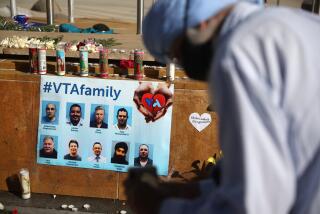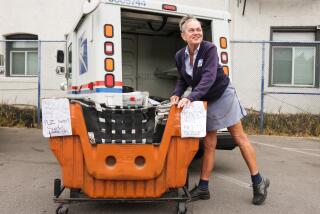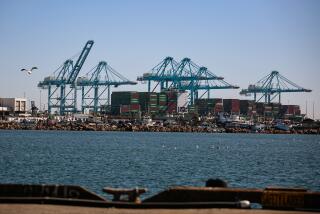Just How Dangerous Is Your Job, Anyway? : Workplaces: Forget the Postal Service. The riskiest vocations in America are fishermen, timber cutters, airplane pilots and taxicab drivers.
- Share via
There’s a pivotal scene in the savage comedy “Ad Wars” at the Tiffany Theater. A stressed-out advertising executive whips a handgun out of his briefcase and starts waving it about in a crowded conference room.
“Put that thing away!” gasps a colleague. “We’re not postal workers!”
The play’s audience understands the reference: There is a widespread belief these days that the U.S. Postal Service is almost as dangerous as a war zone. That conception was reinforced earlier this month when a postal worker shot and killed a supervisor in a City of Industry mail processing facility.
“Murder Ranks 2nd as Cause of Postal Workers’ On-Job Deaths,” said a headline on an Associated Press story that listed five other post office incidents in recent history, including the 1986 slaughter of 14 co-workers by an employee in the Edmond, Okla., post office.
Just how dangerous is it to be a postal worker when compared to other jobs? At the U.S. Department of Labor, Guy Toscano sifted through some statistics this week and reported this: Postal work is one of the safest occupations in the job pool. Postal workers are not even a blip on the Department of Labor’s scale of 1993 occupational fatalities, no matter how the statistics are compiled--by job-related accident or homicide.
“Being a postal worker is not a dangerous occupation, even though we have that impression,” Toscano said. He contends that’s because most of the shootings have been highly publicized.
The Oklahoma tragedy was a major national story because of its 14 deaths, he said. Many of the other post office shootings also claimed multiple victims. “That means they get a lot of hype.”
Despite the impression given by postal incidents and Wednesday’s fatal shooting of four employees of the City of Los Angeles’ General Services Department--apparently by a disgruntled co-worker--offices are not on the list of the most lethal job settings.
There are dozens of more dangerous occupations, said Toscano, an economist with the Bureau of Labor Statistics. “We just started compiling census data on fatal occupations two years ago,” he said. “We have 30 data elements about each incident, so it is very specific.”
Using the U.S. Census data, the bureau has various ways to rank fatal workplaces, he said. “You can look at them by numbers or by risk.”
“Numbers” are the total number of people killed by accident in an occupation. In 1993 (the latest year available), truckers led the list with 699 killed. But, he added, there are probably a million truckers, so that isn’t a high fatality rate.
“Risk” is measured by the number of workers killed in relationship to the number employed. On that scale, commercial fishermen lead the list. “There were 79 fatalities in 1993 [mostly from boating mishaps] and there are only about 50,000 in the United States,” Toscano said. Those numbers put commercial fishing at the top of the “high risk” occupation list with a ratio of 155 fatalities per 100,000 workers. (The national average is five fatalities per 100,000.)
Outdoor jobs are the most dangerous. Ranking second in fatal work injuries are timber cutters (133 per 100,000), followed by airplane pilots (103 per 100,000) and structural metal workers (76 per 100,000). Also making the list are taxicab drivers (50 per 100,000), electrical installers (38 per 100,000), farm operators (36 per 100,000) and construction laborers (33 per 100,000). “As for postal workers,” Toscano said, “you have to remember there are more than 750,000, and they have had something like 30 killed in the last 10 years. So the risk becomes very low--about one per 100,000.”
But the recent postal shooting headlines do bring up another disturbing workplace trend, Toscano said: “Like the society in general, there is a trend toward more personal violence.”
His statistics show that of the 6,271 fatal injuries in the 1993 workplace, 1,063 were homicides, making that the second-leading cause of death on the job. (The other rankings: transportation accidents, first; being struck by falling objects or equipment, third; falls, fourth; exposure to harmful substances, fifth; fires and explosions, sixth.)
Although no one is immune to being murdered on the job, the risk varies greatly among occupations, he said. Taxicab drivers and chauffeurs, with 43 homicides per 100,000, lead the list, Toscano said. “Their ratio is four times higher than a policeman, believe it or not.”
Although there is a public perception that workplace homicides are committed by acquaintances, such as an estranged husband or disgruntled employee, the Labor Department found that 75% of workplace homicides are committed during robberies. People most at risk are those who work alone late at night and are known to handle cash.
Second place in the murdered-at-work category is shared by gas station attendants, sales counter clerks, and police and detectives.
In third place are managers of food and lodging services.
Toscano’s bureau has other ways to look at the information it gathers from the U.S. Census on workplace safety. “For instance,” he said, “you can compare data for the largest metropolitan areas.”
On that list, Los Angeles becomes the second most dangerous city in the country in terms of workplace homicides. In 1993, Toscano said, “There were 279 workplace fatalities in Los Angeles and 42% were homicides. New York is first with 364 fatalities and 46% of its workplace deaths resulting from homicide.”
More to Read
The biggest entertainment stories
Get our big stories about Hollywood, film, television, music, arts, culture and more right in your inbox as soon as they publish.
You may occasionally receive promotional content from the Los Angeles Times.










